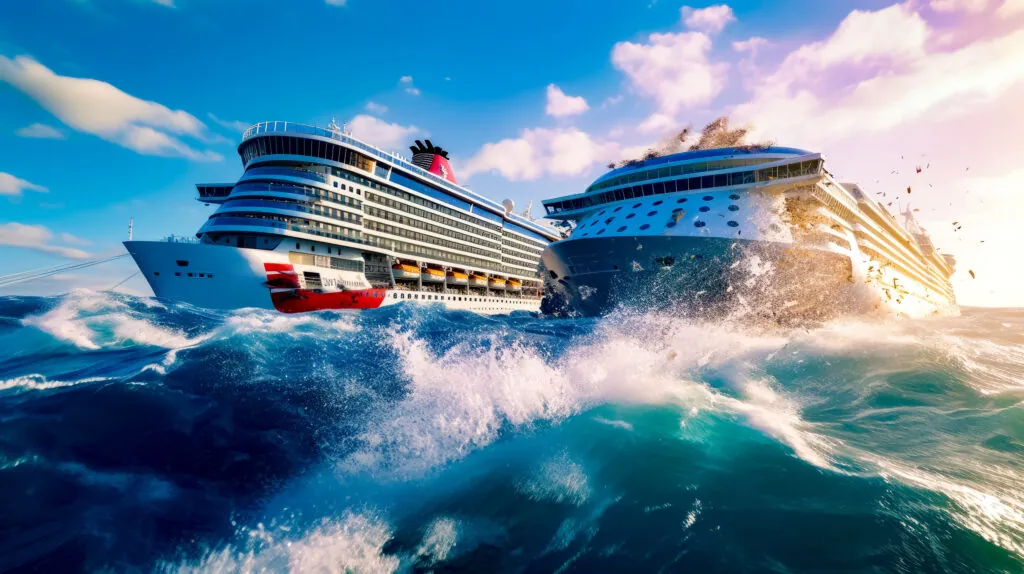In maritime law, precision matters. Distinctions between terms like allision and collision aren’t just semantics—they influence who gets sued, who pays damages, and how insurers respond. These two events may seem similar on the surface, but legally, they are handled very differently.
For vessel owners, insurance companies, port authorities, or maritime attorneys, the ability to distinguish between an allision and a collision is essential. It can be the difference between a straightforward claim and a multi-million-dollar dispute.
What Is an Allision?
Allision Defined Under Admiralty Law
An allision occurs when a moving vessel strikes a stationary object. This object can be a pier, a dock, a buoy, or even a moored ship. The impacted object is not underway and is considered fixed for legal purposes.
Legal Assumptions: The Oregon Rule
In most allision cases, U.S. courts apply what’s known as the Oregon Rule, which presumes that the moving vessel is at fault. This presumption exists because a vessel under control should be able to avoid hitting objects that aren’t moving.
Types of Allision Scenarios
Some common allision incidents include:
- A container ship hitting a wharf during docking
- A ferry striking a buoy while navigating a channel
- A barge drifting into a moored oil tanker during high winds
Each of these would trigger the Oregon Rule and presume the vessel operator is liable unless proven otherwise.
What Is a Collision?
Collision Defined in Maritime Law
A collision involves two or more moving vessels that strike each other while both are underway. This could happen at sea, in a channel, or in a congested harbor.
The Role of COLREGs in Collision Cases
Unlike in allision cases, there’s no automatic presumption of fault in a collision. Instead, courts rely on the International Regulations for Preventing Collisions at Sea (COLREGs) to determine who had the right of way and who may have breached navigational responsibilities.
Real-World Examples of Maritime Collisions
Examples of maritime collisions include:
- Two ships failing to maintain proper lookouts and colliding in open water
- A fishing trawler overtaking a cargo vessel without proper signals
- Two tankers turning simultaneously in a shipping lane and hitting each other
In these cases, both vessels might share the blame depending on the facts.
Key Differences Between Allision and Collision
Stationary vs. Moving: The Defining Factor
The key difference lies in whether the object struck was moving or not. If a vessel hits something stationary, it’s an allision. If two moving vessels strike one another, it’s a collision.
Fault Presumption Is Not Equal
In allision, the moving vessel is presumed at fault. In collisions, fault is determined based on facts and navigation law compliance, and it may be shared between both parties.
Legal Complexity and Risk Exposure
Allisions can seem simpler at first because of the presumption of fault. However, if the stationary object was in the wrong place or unmarked, the moving vessel can argue that it wasn’t entirely responsible. Collisions usually involve more complex legal arguments and negotiation over fault percentages.
Determining Fault in Maritime Incidents
When a Stationary Object Isn’t Entirely Blameless
Although the Oregon Rule favors the stationary object, there are exceptions. If the object was unlit at night, located outside permitted anchorage areas, or was not maintained properly, a court may reduce or remove liability from the vessel.
Investigating Maritime Collisions
In collisions, fault is evaluated through navigational logs, radar data, AIS tracking, eyewitness testimony, and compliance with COLREGs. The court will assess whether each vessel followed the proper rules based on its position, speed, signals, and reaction to the other vessel.
Shared Fault and Contributory Negligence
Maritime law allows for comparative fault, meaning liability can be split. If both vessels made errors, each may bear a percentage of the responsibility. One vessel might be 70% at fault and the other 30%, depending on the findings.
Legal Consequences of Fault
Liability in Allision Cases
Because fault is often clear in allision cases, settlements may happen quickly. However, if the object owner contributed to the hazard, litigation may follow to apportion blame.
Consequences in Collision Cases
Collisions tend to involve lengthier investigations and potentially higher damages. Multiple insurance carriers may be involved, especially when cargo loss, personal injury, or environmental damage occurs.
Insurance Claims After Allision or Collision
How Marine Insurers Treat Allision Incidents
Insurers usually accept that the vessel striking a stationary object is at fault unless proven otherwise. Documentation like weather reports, navigation records, and maintenance logs is critical for rebutting the presumption.
The Complexity of Collision Claims
Collision claims are more complex, as each vessel might have claims and defenses. This means multiple insurance policies, underwriters, and potential subrogation efforts could come into play. Negotiation is often required to allocate fault and financial liability fairly.
Coverage Considerations for Both Scenarios
Different insurance clauses may apply depending on whether the incident was classified as an allision or a collision. Some policies may have different deductibles, liability thresholds, or exclusions tied to the type of incident.
Why These Definitions Matter for Legal and Financial Strategy
Failing to properly identify an incident as either an allision or a collision can have serious consequences. Courts will apply different legal standards, and insurance coverage may vary significantly. Misclassifying an incident could result in denial of a claim, misallocated liability, or a costly legal mistake.
Navigate with Legal Clarity
Understanding whether a vessel incident is an allision or a collision isn’t just a vocabulary issue—it determines how courts assign blame and how insurers process claims. The implications touch every part of the maritime industry, from ship captains and legal teams to port operators and marine insurers.
If you’re involved in a maritime incident, having clarity on what kind of event occurred and how the law treats it could save you significant time, money, and legal trouble.
Frequently Asked Questions (FAQ)
What is the difference between an allision and a collision in maritime law?
An allision occurs when a moving vessel strikes a stationary object, such as a dock, buoy, pier, or a moored ship. A collision, by contrast, involves two or more moving vessels coming into contact with one another while underway. This distinction matters significantly in legal contexts because the allocation of fault is handled differently in each case.
Why is the moving vessel presumed at fault in an allision?
In cases of allision, the legal principle known as the Oregon Rule applies. This rule establishes a presumption that the moving vessel is at fault because, under normal and safe navigation, it should be able to avoid fixed objects. To escape liability, the vessel must demonstrate that the allision was caused by something beyond its control, such as an unmarked obstruction, severe weather, or a mechanical failure despite proper maintenance.
Can the stationary object ever be at fault in an allision?
Yes, although it is uncommon. The owner of the stationary object may be held partially or fully liable if the object was placed in a hazardous or unauthorized location, if it lacked required safety markings such as lights or buoys, or if it was otherwise hidden or improperly maintained. In such cases, courts may determine that the object contributed to the incident.
How is fault determined in a collision between two moving vessels?
Fault in a maritime collision is determined by analyzing the conduct of both vessels leading up to the incident. Courts rely on evidence such as navigation logs, communication records, radar data, eyewitness accounts, and compliance with international maritime navigation rules, particularly the COLREGs (International Regulations for Preventing Collisions at Sea). Both vessels may be found to share responsibility, and liability can be apportioned based on each vessel’s degree of fault.
What happens if both vessels are found at fault in a collision?
When both vessels contribute to the incident, courts often apply a comparative fault analysis, assigning each vessel a percentage of the liability. For example, one ship might be found 60% at fault and the other 40%, depending on their respective actions or failures. Each party may be liable for damages proportionate to their share of the blame, including property damage, injury claims, and environmental remediation costs.
Contact The Cruise Injury Law Firm Today
Don’t let ambiguity in legal terms cost your company in court or through denied insurance coverage. Maritime incidents—whether they involve a docked vessel or an open-sea crash—can lead to serious legal and financial consequences. Contact The Cruise Injury Law Firm today to get expert advice, protect your rights, and ensure you respond appropriately to any vessel incident.




